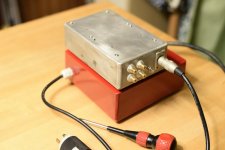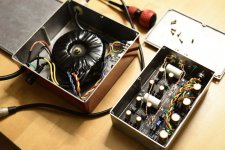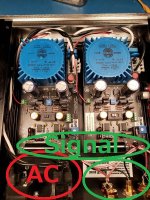Have you read the discussion following you posting the same question at the help desk?
Anyhow, there are phonoclone 3 and phonoclone 4 boards available, they differ in the voltage regulator only. 4 is the most recent variant with the S-Reg shunt reg.
No, there is no need for a buffer.
Anyhow, there are phonoclone 3 and phonoclone 4 boards available, they differ in the voltage regulator only. 4 is the most recent variant with the S-Reg shunt reg.
No, there is no need for a buffer.
Hi Richard, may I know what kind of upgrade compare with Rev 35h?
is it only change in power supply section?
Thank you.
is it only change in power supply section?
Thank you.
Thank you Richard, still love the sound from your Phonoclone.
In case I skip onboard voltage regulator, what is voltage I need, is it +-12V?
I am using kit opamp.
Also very good if you can advise a output capacitor, is it Mcap on above picture?
Thank you.
In case I skip onboard voltage regulator, what is voltage I need, is it +-12V?
I am using kit opamp.
Also very good if you can advise a output capacitor, is it Mcap on above picture?
Thank you.
The limits to the regulated V+ / V- rails are set by the op amp used, but 9-15 V is probably best.
The white caps are Multicap PPFXS iirc. Choice is entirely personal preference.
The white caps are Multicap PPFXS iirc. Choice is entirely personal preference.
Hi RICHARD,
i have buy several year ago the phonoclone.
The R1 mounted is 47Ohm and R2 is 1k; are these specifications that you have recommended for Denon DL103 still valid?
I have also Audio Technica AT F7, i do I have to adjust the values of R1 and R2?
This are the specification the Audio Technica:
Type: Moving coil (MC)
Frequency response: 15 to 50,000 Hz
Output voltage: 0.35 mV (1 kHz, 5cm/sec.)
Channel separation: 27 dB (1 kHz)
Channel balance: 1.5 dB (1 kHz)
Tracking force: 1.8 to 2.2 g (standard: 2.0 g)
Coil impedance: 12 O (1 kHz)
DC resistance: 12 O
Recommended load impedance: Min. 100O (when head amplifier is connected)
Coil inductance: 25 µH (1 kHz)
Static compliance: 35 x 10 - 6 cm/dyne
Dynamic compliance: 9 x 10 - 6 cm/dyne (100 Hz)
Stylus: Nude elliptical stylus 0.2 x 1.7 mil
Suspension wires: Stainless
Vertical tracking angle: 23 degrees
Dimensions: 17.3 (H) x 16.8 (W) x 25.4 (L) mm
Weight: 5.0 g
Many Thanks and happy new year.
Mario.
i have buy several year ago the phonoclone.
The R1 mounted is 47Ohm and R2 is 1k; are these specifications that you have recommended for Denon DL103 still valid?
I have also Audio Technica AT F7, i do I have to adjust the values of R1 and R2?
This are the specification the Audio Technica:
Type: Moving coil (MC)
Frequency response: 15 to 50,000 Hz
Output voltage: 0.35 mV (1 kHz, 5cm/sec.)
Channel separation: 27 dB (1 kHz)
Channel balance: 1.5 dB (1 kHz)
Tracking force: 1.8 to 2.2 g (standard: 2.0 g)
Coil impedance: 12 O (1 kHz)
DC resistance: 12 O
Recommended load impedance: Min. 100O (when head amplifier is connected)
Coil inductance: 25 µH (1 kHz)
Static compliance: 35 x 10 - 6 cm/dyne
Dynamic compliance: 9 x 10 - 6 cm/dyne (100 Hz)
Stylus: Nude elliptical stylus 0.2 x 1.7 mil
Suspension wires: Stainless
Vertical tracking angle: 23 degrees
Dimensions: 17.3 (H) x 16.8 (W) x 25.4 (L) mm
Weight: 5.0 g
Many Thanks and happy new year.
Mario.
I'm looking at reducing the values of the feedback network in order to reduce noise and hum pickup. I did a SPICE simulation, and if I simply drop a decimal place, the same RIAA response is attained.
However, the gain of the second stage is reduced by 14db, and so the first stage must be run 14db hotter.

Any issues with this?
However, the gain of the second stage is reduced by 14db, and so the first stage must be run 14db hotter.

Any issues with this?
Actually, a slight tweak makes it easier to get parts in the exact value, or within tolerance for hand-picking.
75K - Widely available
10.9K - Not available, but on the low side of 1% tolerance 11K resistor.
29.2nF - Not available, but well within 5% tolerance 30nF
10nF - Widely available.
75K - Widely available
10.9K - Not available, but on the low side of 1% tolerance 11K resistor.
29.2nF - Not available, but well within 5% tolerance 30nF
10nF - Widely available.
You could split the gain difference by reducing R3,4 (in your figure above) from 2.2k to 1k ohms, which increases the gain of the second stage 6dB, leaving just 8 to make up for in the first stage.
Thanks! Yeah, I'm trying to avoid loading up the output too much. The OP27 will swing +/-10V into 600 ohms, but I want to be nicer to it than that. The knee of the curve for output swing vs. load is around 1K. Distortion remains low anyway.
So here's a happy medium, 1.21K.

And this is the preamp itself. I built the power supply into the boards themselves, and it's picking up a little hum, which I think will go away with the new feedback values.

So here's a happy medium, 1.21K.

And this is the preamp itself. I built the power supply into the boards themselves, and it's picking up a little hum, which I think will go away with the new feedback values.

Hi Chris,
While it's a compact an efficient layout, the close proximity means there is a risk of noise coupling between the AC wires and the audio signals, as well as from the magnetic fields of the power transformer.
I hope you can manage to get the hum down to manageable levels.
RM
While it's a compact an efficient layout, the close proximity means there is a risk of noise coupling between the AC wires and the audio signals, as well as from the magnetic fields of the power transformer.
I hope you can manage to get the hum down to manageable levels.
RM
Attachments
Yeah, the plan is to move the power supply to another chassis if it still hums, but I wanted to give it a shot without needing a separate chassis.
The hum isn't too bad now, actually.
The hum isn't too bad now, actually.
- Home
- Source & Line
- Analogue Source
- Phonoclone 3


